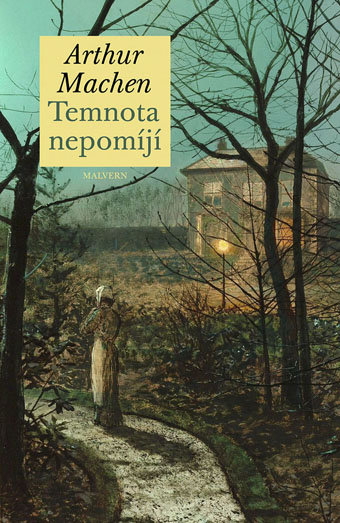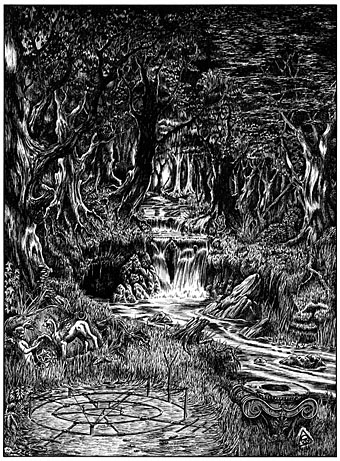Cover art is a detail from A Woman on a Path by a Cottage (1882) by John Atkinson Grimshaw.
The fiction of Arthur Machen doesn’t inspire a great deal of illustration, probably because his best writing is more concerned with the description of particular places and the feelings those places evoke, rather than the depiction of illustratable scenes or events. I did make the attempt myself, however, when I started a series of illustrations in 1990 that were intended for a Savoy Books edition of The White People. This never materialised for a variety of reasons, and I never finished the series of drawings although the work did yield one picture (below), that I’ve always been pleased with.
Some of these drawings may now be seen in Temnota nepomíjí, an edition of Machen’s stories from Czech publisher, Malvern, almost all of which are appearing for the first time in translation. I’m told by the translator, Patrik Linhart, that the title in English would be “Darkness is undying”. As for the cover art, I approve the choice of John Atkinson Grimshaw, a painter whose sombre, autumnal views could cover an entire series of Machen books. His work is often seen today in connection with MR James but being a predominantly urban artist his work seems a better match for the Apostle of Wonder.
Previously on { feuilleton }
• Ibrahim Ineke’s The White People
• The White People
• The Bowmen by Arthur Machen
• Rex Ingram’s The Magician
• The Great God Pan



“The darkness is undying” came from one of his later [I think] stories called “Change”, and it somehow made me think for a moment it meant “There’s no end to the unknown.”
You find a lot of interesting stuff, keep it up.
I love that illustration. What, exactly, is the medium? I’d guess scratchboard, but I often guess that, and in examining the works of other artists, I have been completely incorrect.
Angiportus: Thanks, I think I have that story in a collection, I’ll dig it out for a re-read.
Howard: Thanks. All the Machen illustrations I did were ink on paper. I tried scratchboard (or scraperboard as it’s also known in Britain) many years ago but never explored the medium to use it regularly. The materials are also less easy to find than inks and paper.
FYI – Temnota nepomíjí” – etymologically, verb “pomijet” translates as “to cease” , … its gerund form in the translation – such as “Darkness Unceasing” could also qualify …. especially in suggestion of the timeless continuum, …